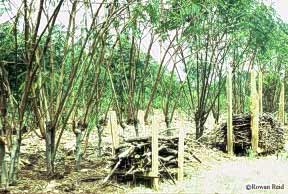|
Soil Compaction & Nutrient Decline

Damage to soil structure and loss of soil fertility threatens
the viability of many agricultural landscapes. Although the
addition of fertilisers and trace elements can be used to
offset losses in soil nutrients, the fertility of soil also
depends on its organic matter content and structure. Nitrogen
fixing tree species offer some potential to enhance soil fertility
over and above any possible impact the trees might have on
soil structure or organic mater content. The photo above shows
the use of Leucaena, a tropical
nitrogen-fixing shrub, being used for fodder, fuelwood, soil
erosion control and nutrient supplement with a maize crop
in Kenya. Nitrogen fixing tree shrubs have also been used
in pine plantations grown on low fertility sandy soils to
boost the nitrogen levels.
.jpg)
Possibly the most valuable contribution trees can make to
soil fertility is through the transfer of nutrients from the
sub-soil to the surface soil. This can occur through litter
fall or as a result of fine root turnover (the growth and
death of the fine feeder roots in the surface soil). Research
in eucalypt forests suggests that a large proportion of the
nitrogen, phosphorous and potassium, and 100% of calcium taken
up by trees will be dropped on the surface soil as fine litter
(leaves and branches). Because most tree species actively
extract nutrients from the leaves before they shed, pruning
or harvesting of green branches can further increase the cycling
of nutrients. Nutrient cycling may be an important means of
recovering leached bases (including calcium) and nitrates
from under pastures, which are the primary cause of soil acidification.
Organic matter binds with soil nutrients, stores water and
enhances soil structure and drainage. Maintaining or building
soil organic matter levels also contributes to the control
of greenhouse gases. Conversion of forests and woodlands to
pastures commonly leads to a reduction in soil organic matter
content. This is further reduced if the land is cultivated
in any way. Although this would suggest that re-establishing
a forest on farmland will lead to a build up of soil organic
matter, this may take many years. In fact, if ripping or cultivation
is used to establish the trees, the soil organic matter content
might actually drop before the trees are able to begin turning
over litter and rebuilding the soil.
Back to top
|
